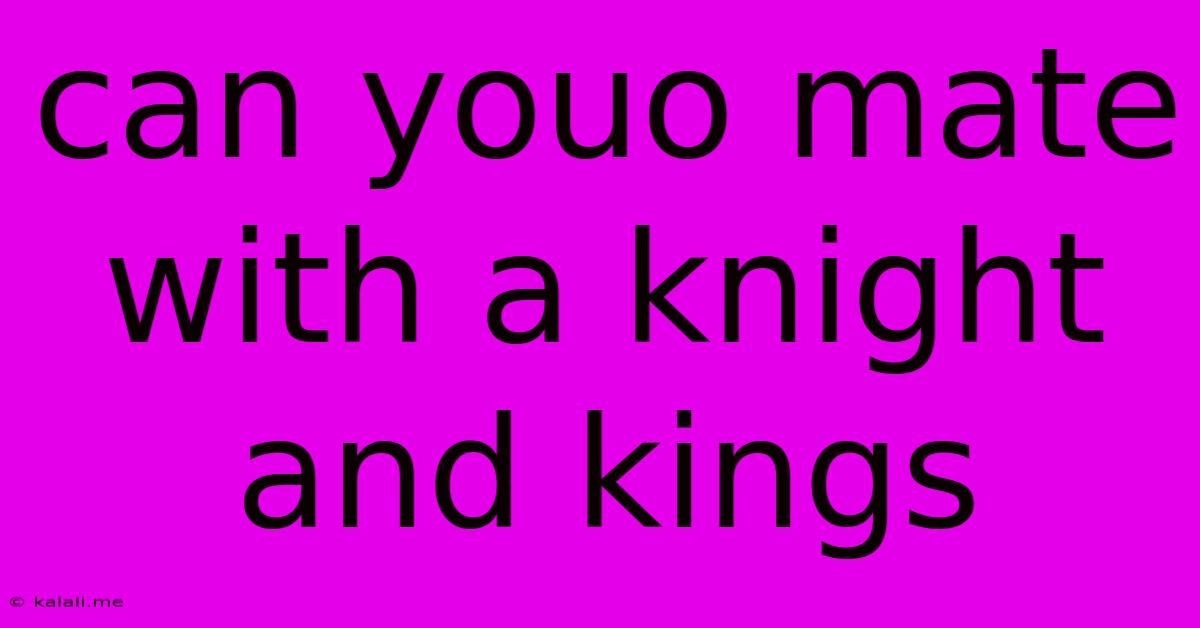Can Youo Mate With A Knight And Kings
Kalali
May 24, 2025 · 3 min read

Table of Contents
Can You Mate with a Knight and King? The Unexpected Power of the Minor Piece
The endgame is often where chess games are won or lost. While the queen is undeniably powerful, sometimes a seemingly humble knight, paired with the king, can deliver a checkmate. This article delves into the surprising mating possibilities with just a knight and king against a lone king. It's a fascinating exploration of positional chess and demonstrates the vital role of subtle maneuvering in the endgame.
The scenario of a lone king facing a king and knight is not as straightforward as it might initially appear. It's not a guaranteed win for the knight and king side; it requires precise calculation and a strong understanding of the king's defensive capabilities. The key to success lies in restricting the opposing king's movement and forcing it into a position where checkmate becomes inevitable.
Understanding the Limitations
Before we explore the mating patterns, it's crucial to understand the limitations. A single knight cannot deliver a checkmate on its own. It needs the cooperation of the king to control squares and restrict the opponent's options. This is why understanding king activity and the interplay between the king and knight are paramount.
The opponent's king, though seemingly weak, is surprisingly resilient in this scenario. Its ability to move one square in any direction gives it unexpected defensive resources. Therefore, the attacking side needs to use the knight's unique movement pattern effectively to restrict the king's escape routes and force it into a corner.
Key Principles for Checkmating with King and Knight
Several principles govern successful mating combinations with a king and knight:
-
King Cooperation: The king must actively participate in the attack, controlling key squares and preventing the opposing king's escape. This isn't a passive role; the king must actively engage.
-
Limiting the King's Movement: The goal is to confine the lone king to a small area of the board. This is achieved through careful maneuvering, strategically placing the knight and king to block escape squares.
-
Calculating the Checkmate: This isn't a spontaneous affair. Each move must be calculated, anticipating the opponent's response and ensuring a path to a checkmate. Careful planning is essential.
-
Understanding Knight Movement: The knight's unique L-shaped movement is crucial. It allows for jumps over pieces, creating surprising tactical opportunities and attacking from unexpected angles. Mastering its movement is key to success.
-
Patience and Precision: This endgame requires patience. Rushing the attack can easily allow the opponent to escape the pressure. Precision in each move is paramount.
Illustrative Example (Simplified)
While demonstrating a full mating sequence requires a visual aid (a chessboard), we can illustrate a simplified concept. Imagine the opposing king trapped near a corner of the board. The knight and king can then work together, using the knight's unique movement to deliver a check, and the king's movement to prevent escapes, ultimately forcing a checkmate. The exact maneuvers depend on the king's position, highlighting the dynamic nature of the endgame.
Conclusion
Checkmating with a king and knight is a testament to the intricacies of chess. It showcases the importance of subtle positional understanding, precise calculation, and the often-underestimated power of a seemingly weaker piece. It's a fascinating endgame study and a rewarding challenge for any chess player looking to improve their endgame skills. Mastering this type of endgame contributes significantly to a stronger overall chess game.
Latest Posts
Latest Posts
-
Fake Kicking Someone Out Of Store
May 24, 2025
-
Flow Velocity Vs Pump Power Consumption
May 24, 2025
-
How To Stop A Rooster From Crowing
May 24, 2025
-
How To Get Gasoline Smell Off Of Hands
May 24, 2025
-
Off The Top Of My Head
May 24, 2025
Related Post
Thank you for visiting our website which covers about Can Youo Mate With A Knight And Kings . We hope the information provided has been useful to you. Feel free to contact us if you have any questions or need further assistance. See you next time and don't miss to bookmark.